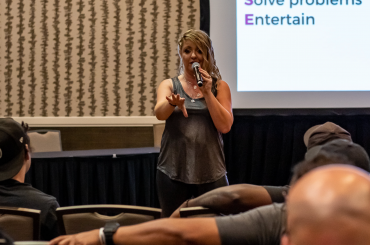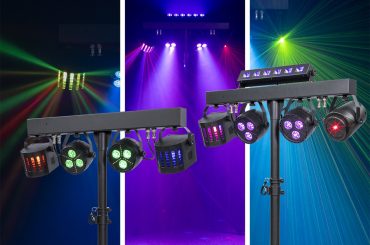Photo Booths Endure as an Upsell That Keeps on Paying Dividends to DJs. Will the Fun Ever End?
When Lisa Vasberg of Cheers Entertainment in Newbury Park, Calif., bought her first photo booth outfit in 2009, she was thinking the fad would only last a couple years. After running all the numbers and thinking it would be a short-term play, she figured her investment would at least pay for itself and possibly be more substantial.
Now approaching her fifth year providing photo booths for parties in Southern California, Vasberg admits that, while the booth market has certainly become overly saturated, its popularity hasn’t slowed down at all.
“I actually had to buy another booth to keep up with all the demand,” she says. “Y es, prices have gone down because of the saturation, but not too much, and now we use them at every kind of event.”
es, prices have gone down because of the saturation, but not too much, and now we use them at every kind of event.”
We recently contacted DJs from across the country and inquired about the popularity in their markets of the photo booth—an upsell that doesn’t appear to be going away like others have. It seems even local pubs nowadays have jukeboxes that print out “selfies.”
At what types of events are mobile DJs utilizing photo booths? Are we using them more now than three to five years ago? How much are we charging? And do we think this fad might last forever?
While JR Silva of Silva Entertainment in Orlando, Fla., says that over-saturation has seemed to spoil the financial impact of the photo booth market in his region of the country, Artem Lomaz of New Jersey’s Ninety-Three Entertainment claims photo booths are one of the top additional elements that clients look for at his corporate events, allowing everyone to gain a sense of interaction.
As for Vasberg back over on the West Coast, she is even seeing companies selling photo booths as their sole business. “A lot of these companies built their own booths—some built well and some not so much—and now I see a portion of these companies going out of business because they can’t get enough work to sustain themselves,” she says. “There’s been a huge onslaught of saturation, which created an extremely competitive market for the companies that just sold photo booth packages as opposed to my situation, where they’re an upsell with my entertainment packages.
“Even though a photo-booth package is primarily an upsell for our company, this division is technically not a division, but in actuality is like running a separate business. I’ve had to hire someone to maintain this portion of the company, so I can still concentrate on the overall entertainment. Yes, it costs money to have someone else help, but now both divisions are running efficiently and bringing in a nice profit.”
Vasberg says she doesn’t foresee the photo-booth phenomenon going away any time soon, and when she’s getting $800 tot $1,200 for four hours of providing this extra aspect of her business, she’s quite fine with that, too.
Further up the California coast, Patrick McMichael of Denon & Doyle Entertainment in the San Francisco Bay Area says it was the popularity of photo booths that really helped carry their company through the entertainment depression of 2008-’09, a time when they were used mainly for weddings and bar/bat mitzvahs and other various social niches.
Although he doesn’t anticipate the photo booth phenomenon going away anytime soon, McMichael says the overall perception of them has certainly changed among Denon & Doyle’s clientele.
“Similar to the wave of new photographers that came along after the digital camera became common, the photo-booth industry has become extremely saturated in the California market,” he explains. “As a business model, we’ve had to adjust how we approach providing the product to our customer.
“Price points have dipped because the novelty isn’t there the way it was five years ago—guests simply want a ‘photo booth.’ Whether that means a camera on a tripod, a tent with an open-air style machine or a classic hard-walled quality piece of equipment, it’s still a photo booth.”
Denon & Doyle has responded by broadening the scope and idea of what a photo booth is. Says McMichael: “Clients will call in asking for a ‘green-screen photo booth’ or a ‘flip-book photo booth,’ so we’ve taken all of our photo products and lumped them into this category.”
In fact, McMichael says Denon & Doyle actually is doing even more photo-style services than they did during the recession of ’08 and ’09, though the definition of the photo booth has changed because corporate events and trade-shows have also become a huge market in this segment of their business.
“Our team has developed several creative ways to integrate new technology to allow for social media sharing—Twitter, Facebook, Instagram, Flickr, etc.—allowing the corporate planner and marketing team of our clients to sell the idea of reaching tens of thousands more potential customers via photo-booth branding campaigns.
“We anticipate this is where we’ll see the most growth over 2014. The photo booth isn’t going anywhere, but the way we sell it will forever be a creative dance.”
Back over in the Northeast, Mike Weider of New Jersey’s Ultimate Sounds Entertainment recalls first talking with his business partner (his wife) at a DJ Expo in Atlantic City about adding a photo booth to their company’s entertainment arsenal.
“While still in the lobby I started approaching other local Jersey entertainment companies and informing them that we now owned a photo booth that they could rent from me, even before I had actually bought one,” he chuckles. “As someone who loves to pre-sell, the booth was pretty much paid for before the end of that convention.”
Weider says his initial thought regarding photo booths was that they would primarily be used at weddings and bar/bat mitzvahs, but he soon found he had underestimated their popularity.
“Our booth was going out regularly for not only weddings and mitzvahs, but also for corporate events, Sweet 16s, fundraisers, bar promotions and more,” he recalls. “It seemed that just about every call we received was an inquiry about photo booths. It became our No.-1 upsell, usually generating us an extra $1,000-$1,500 per event.
“My favorite part of it was that we would get calls from other companies wanting to rent our booth—at a reduced rate—as well as direct calls just for the photo booth.”
Weider claims that photo booths are an upsell in his market that are just as popular today as they’ve ever been. “I think the reason for its popularity is it’s a novelty/favor that’s unique and fun, as well as a great takeaway,” he explains. “To the young guests, it’s fun, and it transports the older guests back to their youth ‘walking on the boardwalk’ or whatever. Whether it’s the props or the keepsake scrapbook, the experience is never the same twice.
“Providing a photo booth is one thing, but then again we don’t just provide a photo booth. We provide our clients with a fun, interactive experience as well as fond memories for both the guests and the party hosts.”
Dave Stephenson of A Time For Music & Memories in Douglassville, Pa., started a group on Facebook when he got into the photo-booth business two years ago, and today that group boasts close to 1,000 members—including other DJs as well as manufacturers and software developers that share ideas and new innovations in the industry.
He says the popularity of photo booths is due to the desire for instant gratification—“The days of waiting for your pictures to come back from a developer are gone,” he says. Also, it’s due to the fact that today’s mobile DJs provide a lot more varied entertainment than we did three decades ago (when he first got into the business).
“Photo booths create memories that will last forever,” Stephenson says. “People want their pictures right away and want to be a star when they want to let loose. The software and technology is making it affordable and more portable. Add in social media and branding, and you have the ability to have your marketing all over the product.
“People can now upload to all their social media accounts or email the photos right after they are done. There are systems that can fit in the back seat of a car, just like new advances in DJ technology are getting smaller and easier to carry and compete.”
By interacting with people from all over the world about photo booths every day on his Facebook pages, Stephenson says companies are always finding ways to set themselves apart from each other.
“Photo booths allow for extra revenue for my DJ business, and it’s helped build my DJ business as I’ve had people call about the booth and see I also have a DJ business,” he says. “I’ve done everything from baptism parties to weddings to corporate functions.
The nice thing about the booths is they can be custom-branded for events, and they can fit into really any event you can imagine. I’ve even seen booths being used in department stores to promote new products, right next to a DJ.”
New to the industry, of course, is the green-screen technology that allows the company operating a photo booth to photograph someone appearing to be in a cool location where they might never have before been—or ever will be.
“Weddings represent the majority of my events, so I sit with my couples and design my booth to blend in with their reception,” says Stephenson. “The booth should not be the focus of the wedding or the event, so it’s there to add a little piece of the day that someone can look at later and remember the event. I give all my customers a copy of all the pictures taken at the end of the event so they can look at them and enjoy the memories.”
Up in Ogunquit, Maine, Jerry Bazata of DJ Jaz Music & Entertainment says his perception has always been that offering a photo booth at his events would not be financially beneficial, so he’s chosen to develop relationships with other vendors in the industry who provide that service.
“In the final analysis of determining if it was beneficial for me to purchase one, the answer was clearly no,” says Bazata. “As a sole operator, I determined the fixed costs of providing this service didn’t provide a sufficient ROI for me to dedicate capital, so instead I allocate that money towards what I know best—which is uplighting and DJ equipment.
“However, the real opportunity for me was to build upon referrals and a network of vendors that would help us both increase our bottom lines. I knew that photographers could easily integrate this into their company, and it would be a much easier sell for them than for me. Therefore, I contacted several photographers and two companies in the Boston and Maine markets to begin setting up referrals for photo booths.”
Bazata said a case in point was just this past year, when he was negotiating a contract for a high school prom and the advisors mentioned the idea of having a photo booth.
“I contacted a vendor and they made the sale, which reinforced my value proposition to the school as a trusted adviser to their entertainment needs,” he explains. “A week later that same photo-booth vendor called me and referred a wedding client for whom I was able to book a comprehensive wedding package that included uplighting.
“This is just one example of many in which I’ve increased revenue and continued to build my referral network.”
In the end, at least in his area of the country, Bazata firmly believes that offering services outside of the core business model of a single-DJ operator—providing music, master of ceremony services and lighting—has not developed the sufficient value to incorporate into his company’s offerings.
“You can, however, make the case,” he adds, “for those who have successfully developed a market in parties and corporate events.”
Likewise, Mike Maloney of M&M Entertainment in South Portland, Maine, says he prefers to have a working relationship with a local photo booth company. He gets 10-percent of any package they book after he sends a referral their way, which results in $100-$120 per gig.
“It helps them and it limits my risk, though I’ve not found a company willing to do the same with lighting,” Maloney says. “It’s most popular for bar and bat mitzvahs, and about 90-percent of corporate parties and 40-percent of wedding receptions.
“I think they’re a fad. They’re already less popular at weddings than they were three years ago. The corporates that have them love them, as well as the mitzvahs, but I’ve noticed they don’t fit every occasion. Companies that have multiple locations, for example, don’t take to the photo booths as well as those who all work in one location.”
However, Maloney does see photo-booths having the potential to last long into the future for at least mitzvahs. “But then again,” he says, “the very nature of teenagers leads me to believe—with no concrete proof, per se—that at some point they’ll just start thinking the photo booths are silly.”
Then again, since corporate parties and wedding receptions typically include the alcohol factor, the long-range potential for increased bookings of photo booths for those events provide more hope for their long-term viability.
[button_2 color=”#ff0011″ size=”button-med” icon=”none” text=”Read More From This Issue” link=”http://viewer.zmags.com/publication/20ad5266#/20ad5266/4″]








